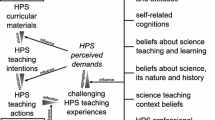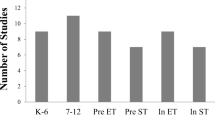Abstract
This work is a systematic review of studies that investigate teaching experiences applying History and Philosophy of Science (HPS) in physics classrooms, with the aim of obtaining critical and reliable information on this subject. After a careful process of selection and exclusion of studies compiled from a variety of databases, an in-depth review (general description, analysis of quality and summary of the results) of those considered to be of high quality was undertaken. The results indicate positive effects in the didactic use of HPS in relation to the learning of physics concepts, although there was no consensus regarding this. A stronger divergence was found regarding the occurrence of change in students’ attitudes towards science. However, HPS may in fact foster a more mature vision in students in respect of their understanding of the Nature of Science (NOS). Moreover, potentially favourable results were found regarding the effects of the didactic use of HPS on the quality of argumentation and metacognition, although further research in this area would appear necessary.




Similar content being viewed by others
Notes
Articles such as Cooley and Klopfer (1963), Welch and Walberg (1968) or Aikenhead (1974), although approaching the evaluation of specific teaching strategies using history of science (History of Science Cases in the first study and Harvard Project Physics in the others), did not appear in this research database as their main focus was to analyze the evaluation methodology used.
The same type of systematic review (using the same criteria) is being undertaken by the authors in the five main Brazilian journals in the area of science teaching (and of physics teaching), as well as an important Spanish-language journal. Of the 117 works selected, 11 meet the exclusion criteria for in-depth analysis, which is quantitatively similar to the number found in the present study. This, allied to the fact that many studies presented at local and international congresses are not converted into published articles, suggests that a greater number of studies on this subject are being undertaken than the international community is aware of.
Even though the strategy presented by Egan is located, according to Matthews (1994), in the Storyline Approach, representing a middle road between the “add-on” and integrated approaches, the authors of Study E explicitly used scientists’ life stories (in one of the didactic strategies) in a way that was disconnected from scientific concepts and NOS.
References
Abd-El-Khalick, F., & Lederman, N. G. (2000a). Improving science teachers’ conceptions of nature of science: A critical review of the literature. International Journal of Science Education, 22(7), 665–701.
Abd-El-Khalick, F., & Lederman, N. G. (2000b). The influence of history of science courses on students’ views of nature of science. Journal of Research in Science Teaching, 37(10), 1057–1095.
Abi-El-Mona, I., & Abd-El-Khalick, F. (2006). Argumentative discourse in a high school chemistry classroom. School Science and Mathematics, 106(8), 349–361.
Aikenhead, G. S. (1974). Course evaluation II: Interpretation of students performance on evaluate tests. Journal of Research in Science Teaching, 11(1), 23–30.
Aikenhead, G. S. (2003). Review of research on humanistic perspectives in science curricula. Paper presented at the European science education research association (ESERA) 2003 Conference. Noordwijkerhout, The Netherlands, August 19–23.
Albe, V. (2008). When scientific knowledge, daily life experience, epistemological and social considerations intersect: Students’ argumentation in group discussions on a socio-scientific issue. Research in Science Education, 38, 67–90.
Bennett, J., Lubben, F., & Hogarth, S. (2007). Bringing science to life: A synthesis of the research evidence on the effects of context-based and STS approaches to science teaching. Science Education, 91, 347–370.
Bennett, J., Lubben, F., Hogarth, S., & Campbell, B. (2005). Systematic reviews of research in science education: Rigour or rigidity? International Journal of Science Education, 27(4), 387–406.
Cassidy, D., Holton, G., & James Rutherford, F. (2002). Understanding physics. New York: Springer.
Chi, M., Slotta, J., & Leeuw, N. (1994). From things to processes: The theory of conceptual change goes learning science concepts. Learning and Instruction, 4, 27–43.
Cooley, W. W., & Klopfer, L. E. (1963). The evaluation of specific educational innovations. Journal of Research in Science Teaching, 1, 73–80.
Dios, J. G., & Santamaría, A. B. (2007). Revisión Sistemática y Metanálisis (I): Conceptos Básicos. Evidencias en Pediatría, 3, 107.
Driver, R., & Easley, J. (1978). Students and paradigms: A review of literature related to concept development in adolescent science students. Studies in Science Education, 5, 61–84.
Egan, K. (1985). Teaching as story-telling: A non-mechanistic approach to planning teaching. Journal of Curriculum Studies, 17(4), 397–406.
Egan, K. (1989). Teaching as story telling: An alternative approach to teaching and curriculum in the elementary school. Chicago: University of Chicago Press.
Erduran, S., Simon, S., & Osborne, J. (2004). TAPing into argumentation: Developments in the application of Toulmin’s argument pattern for studying science discourse. Science Education, 88(6), 915–933.
Gil, D., Carrascosa, J., Furió, C., & Martínez, J. (1991). La Enseñanza de las Ciencias en la Educación Secundaria. Barcelona: ICE-Horsori.
Holton, G. (1964). The goals for science teaching. In S. C. Brown, N. Clarke, & J. Tiomno (Eds.), Why teach physics?. Massachusetts: M.I.T Press.
Jiménez-Aleixandre, M., Muñoz, C, Cuadrado, V. (2000a). Expertise, argumentation and scientific practice: A case study about environmental education in the 11th Grade. Paper presented at the annual meeting of the national association for research in science teaching (NARST), New Orleans, L.A., April (ERIC Document Reproduction Service no ED 439 960).
Jiménez-Aleixandre, M., Rodríguez, A., & Duschl, R. (2000b). “Doing the lesson” or “doing science”: Argument in high school genetics. Science Education, 84(6), 757–792.
Justi, R., & Gilbert, J. (2000). History and philosophy of science through models: Some challenges in the case of ‘the atom’. International Journal of Science Education, 22(9), 993–1009.
Lecompte, M. D., & Goetz, J. P. (1982). Problems of reliability and validity in ethnographic research. Review of Educational Research, 52(1), 31–60.
Linjse, P. (2004). Didactical structures as an outcome of research on teaching-learning sequences? International Journal of Science Education, 26(5), 537–554.
Marín, N. (1999). Delimitando el Campo de Aplicación del Cambio Conceptual. Enseñanza de las Ciencias, 17(1), 80–92.
Matthews, M. (1992a). History, philosophy and science teaching: The present rapprochement. Science & Education, 1(1), 11–47.
Matthews, M. (1992b). Constructivism and empiricism: An incomplete divorce. Research in Science Education, 22(1), 299–307.
Matthews, M. (1994). Science teaching: The role of history and philosophy of science. New York: Routledge.
Millar, R. (1989). Constructive criticisms. International Journal of Science Education, 11(5), 587–596.
Monk, M., & Osborne, J. (1997). Placing the history and philosophy of science on the curriculum: A model for the development of pedagogy. Science Education, 81(4), 405–424.
Moreira, M. A., & Greca, I. M. (2003). Cambio Conceptual: Análisis Crítico y Propuestas a la Luz de La Teoría del Aprendizaje Significativo. Ciência & Educação, 9(2), 301–315.
Mortimer, E. F. (1995). Conceptual change or conceptual profile change? Science & Education, 4(3), 265–287.
Munby, H. (2003). Educational research as disciplined inquiry: Examining the facets of rigor in our work. Science Education, 87(2), 153–160.
Munford, D., Zembal-Saul, C. (2002). Learning science through argumentation: Prospective teachers’ experiences in an innovative science course. Paper presented at the annual meeting of the national association for research in science teaching (NARST), New Orleans, L.A., April (ERIC Document Reproduction Service no ED 465 520).
Robinson, J. T. (1969). Philosophical and historical bases of science teaching. Review Educational Research, 39(4), 459–471.
Rowlands, S., Grahan, T., & Berry, J. (1999). Can we speak of alternatives frameworks and conceptual change in mechanics? Science & Education, 8, 241–271.
Rutherford, J. F. (2001). Fostering the history of science in American science education. Science & Education, 10(6), 569–580.
Seroglou, F., & Koumaras, P. (2001). The contribution of the history of physics in physics education: A review. Science & Education, 10(1), 153–172.
Seroglou, F., Koumaras, P., & Tselfes, V. (1998). History of science and instructional design: The case of electromagnetism. Science & Education, 7, 261–280.
Wandersee, J. H. (1985). Can The history of science help science educators anticipate students’ misconceptions? Journal of Research in Science Teaching, 23(17), 581–597.
Welch, W. W. (1973). Review of the research and evaluation program of Harvard project physics. Journal of Research in Science Teaching, 10(4), 365–378.
Welch, W. W., & Walberg, H. J. (1968). A design for curriculum evaluation. Science Education, 52(1), 10–17.
White, R. T., & Arzi, H. J. (2005). Longitudinal studies: Designs, validity, practicality, and value. Research in Science Education, 35, 137–149.
List of Studies Selected for Analysis
A Heering, P. (2000). Getting shocks: Teaching secondary school physics through history. Science & Education, 9(4), 363-373.
B Carvalho, A. M. P., Vannucchi, A. I. (2000). History, philosophy and science teaching: Some answers to “how?” Science & Education, 9(5), 427-448.
C (a) Galili, I., Hazan, A. (2000). The influence of an historically oriented course on students’ content knowledge in optics evaluated by means of facets-schemes analysis. American Journal of Physics, 68(S1), S3–S15.
C (b) Galili, I., Hazan, A. (2001). The effect of a history-based course in optics on students’ views about science. Science & Education, 10(1–2), 7–32.
D Solbes, J., Traver, M. (2003). Against a negative image of science: History of science and the teaching of physics and chemistry. Science & Education, 12(7), 703–717.
E Seker, H., Welch, L. C. (2006). The use of history of mechanics in teaching motion and force units. Science & Education, 15(1), 55-89.
F Klopfer, L. E., Cooley, W. W. (1963). The history of science cases for high schools in the development of student understanding of science and scientists: A report on the HOSC instruction project. Journal of Research in Science Teaching, 1(1), 33-47.
G Pocovi, M. C. (2007). The effects of a history-based instructional material on the students’ understanding of field lines. Journal of Research in Science Teaching, 44(1), 107-132.
H Ogunniyi, M. B. (1987). Conceptions of traditional cosmological ideas among literate and nonliterate nigerians. Journal of Research in Science Teaching, 24(2), 107–117.
I Hosson, C., Kaminski, W. (2007). Historical controversy as an educational tool: Evaluating elements of a teaching-learning sequence conducted with the text “dialogue on the ways that vision operates”. International Journal of Science Education, 29(5), 617–642.
J Nott, M. (1994). Teaching physics and the nature of science together: A case study. Physics Education, 29(3), 170–176.
K Dedes, C., Ravanis, K. (2009). Teaching image formation by extended light sources: The use of a model derived from the history of science. Research in Science Education, 39(1), 57-73.
Author information
Authors and Affiliations
Corresponding author
Rights and permissions
About this article
Cite this article
Teixeira, E.S., Greca, I.M. & Freire, O. The History and Philosophy of Science in Physics Teaching: A Research Synthesis of Didactic Interventions. Sci & Educ 21, 771–796 (2012). https://doi.org/10.1007/s11191-009-9217-3
Published:
Issue Date:
DOI: https://doi.org/10.1007/s11191-009-9217-3




